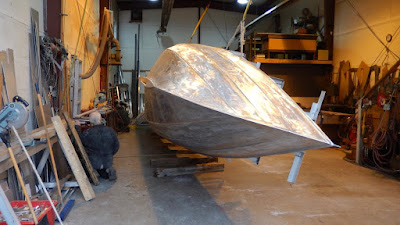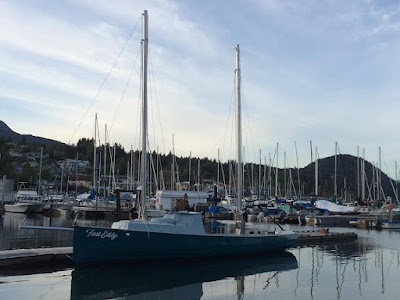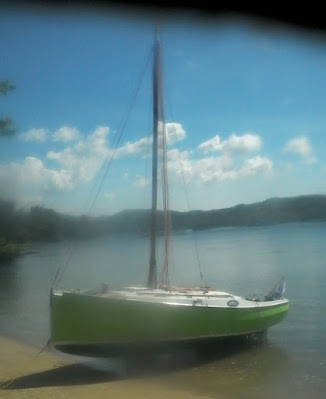I drew Fast Eddy in 2017 for Seaforth Expeditions in Sechelt, British Columbia, Canada. Her purpose is adventure cruising in the desolate wilderness waters of Eastern British Columbia. These waters are mostly sheltered by the many islands but can be wild and treacherous, with strong tides and unchartered rocks. They are also known for the massive logs that litter the shores, having escaped from the logging companies. Those that have not yet found a beach are a danger to boaters, particularly when they are nearly waterlogged and floating vertical, with only a few inches of one end above the surface and very difficult to see. Ready to punch a hole in a hull right at waterline, they are known as deadheads.
 |
| Gaff schooner sail plan |
Aluminium was chosen for this boat as the best material to survive potential collisions with deadheads or rocks when far from any rescue services. As an added safety feature, most of the space between hull and deck is foam-filled for flotation.
The hull is the same family as my lapstrake plywood Cape series of designs and we decided to keep the lapstrake format, for the character that it adds to a classic hull form. That meant that between the builders and myself we had to work out construction details that would look good, without excessive welding that aggravates heat distortion. Built by John Dearden of Gibsons BC, helped by owner Tom McPherson and his dad, they did a beautiful job of the build.
 |
| Aluminium Fast Eddy hull on turn-over day. |
The work for this boat after launch is taking charters into those wilderness waters for adventure camp/cruising, nature photography touring, youth training, corporate team building and similar activities far from comfortable civilization. It is work that needs to be done with absolute minimum disruption of nature and zero destruction of the places that they visit. To that end, this is a sailing and rowing boat, with a backup outboard motor stowed in a locker and only used as a last resort.
The cockpit takes up most of the length, with four rowing positions on each side. Under the seats are personal storage lockers and between them are insulated food lockers. Insert panels convert the individual seats to long sleeping platforms. Forward of the cockpit is a bow cabin with enclosed heads, galley and V-berths.
The sailing rig is gaff schooner, basically a cutter rig forward, with the normal boom replaced by a wishbone boom and stepped in a tabernacle to fold aft. Another identical mast and sail, without headsails, stands aft. This one is also stepped in a tabernacle but folds forward. The pivots are rotated 2 degrees off centreline so that the masts pass each other and each rests in a cradle on the tabernacle of the other.
 |
| Primed ready for paint, tubes still to be completed as masts. |
This boat is a maxi trailer-sailer, at 35ft long and only 8'3" wide. It is very slim, with extremely fine bow. This makes it easily-driven for rowing and for sailing in light breezes. Sailing reports are that it is very quick as long as there is some breeze. She competed in the R2AK event in 2019, averaging 3.3 knots in mostly rowing conditions but recorded 13 knots in the stronger breeze of the finishing stretch.
 |
| Launch day. |
To see this and our other designs, go to our
main website or our
mobile website.










































